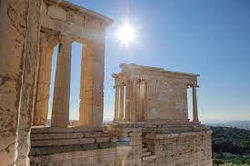
Temple of Athena Nike
The Temple of Athena Nike, a beautiful example of Ionic architecture, sits high on Athens' Acropolis. Some call it the Temple of Wingless Victory. Its elegant columns, fluted with delicate precision, rise against the bright blue sky, showcasing to the artistic power and devotion of the Athenians to their goddess. Though small and weathered by time and war, the temple stand as testaments to a rich history and intricate ornamentation.
Originally named for Athena, the goddess of wisdom, crafts, and warfare, the temple's purpose was tied to a special legend. When Poseidon and Athena competed for the patronage of the city, it was Athena's gift of the olive tree that won the hearts of Athenians. To show their gratitude, the Athenians made Athena their guardian and forever linked her image with triumph. This strong link to victory is also seen in the temple's alternate name, the Temple of Wingless Victory.
Why is the temple named as Wingless Victory? According to lore, the Athenians sculpted Nike, the winged goddess of victory, specifically without wings. This deliberate choice, the story goes, was to ensure that victory would never abandon their city, forever secured to the sacred ground of the Acropolis.
The temple has seen the ups and downs of Athenian history, bearing the scars of wars and the plunder of time. By the 21st century, only a few of its once-proud columns were left standing. The intricate friezes, though weathered, hint at the artistry that once decorated the temple. Tales of Olympian gods, epic battles against Persian foes, and even clashes between Greek warriors once danced across the temple's surface, reminding us of the Athenians' captivating past.
 |  |  |  |
|---|
Myths about Goddess Nike
Two tales of Nike, goddess of victory, stand out among all myths about her. In the first, she's not just a trophy, but a fierce co-pilot. Imagine a thunderous war between mighty gods and ancient Titans. High above the fray, Zeus, king of the gods, rides his chariot. But he's not alone. Nike, wings tucked tight, grips the reins, guiding the charge. Her sharp eyes scan the battlefield, her presence a terrifying promise of victory for Zeus.
The second myth paints a different picture. Here, Nike isn't locked in battle, but a swift herald of its end. Picture the dust settling, the air thick with the cries of victors and vanquished. Suddenly, a blur of wings! Nike swoops down, golden sandals skimming the ground. She lands before the champion, a laurel wreath held high. With a gentle touch, she places it on their head, forever etching their name in the annals of glory.
These contrasting myths reveal the two sides of Nike's power. She's not just the lucky charm at the finish line, but the fierce drive that pushes you there. She's the thunderous roar of triumph and the gentle whisper of recognition. And whether hurtling through the sky or carefully placing a crown, Nike's wings always remind us that victory may have many faces, but it always bears her mark.